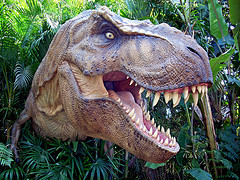 Yahoo News puts it this way:
Yahoo News puts it this way:
Based on the small sample we’ve recovered, chickens may be the closest relatives (to T. rex),” says geneticist John Asara of Beth Deaconess Medical Center in Boston, co-leader of a team reporting the discovery of faint traces of chicken-like bone lining preserved inside a dinosaur drumstick.
Secure · Tax deductible · Takes 45 SecondsSecure · Tax deductible · Takes 45 Seconds
Science says it this way:
To address this latter possibility, we generated aligned sequences obtained from chicken collagen 1t1 (the most closely related sequence to that of ostrich in the public database) with those from frog and Japanese newt (Cynops pyrrhogaster) (the next most closely related sequences in the database). For predicted tryptic fragments where one or more of these three taxa diverged at more than one residue, we generated a set of theoretical peptide/protein sequences that included the exact sequence in regions where all three species were identical and various combinations of the observed variant amino acids at residues where the three species diverged. We assumed that differences between chicken and ostrich are most likely to occur at residues that have been observed to drift from chicken to frog and newt. Because chicken is phylogenetically closer to ostrich than frog or newt, we chose the residue observed in chicken as the most likely residue when all three species differed at a location but chose the majority residue where two out of three were identical at a given position. For this example, we predicted a theoretical drift from chicken that waslikelytobeobservedinarelatedspeciessuch as ostrich. This sequence (as well as other sequences predicted in an analogous manner) matched MS/MS fragmentation patterns from ostrich bone extract as well as a synthetic peptide created for sequence validation.
Interestingly, the typo with the missing spaces between words is actually in the online version of Science. You would think that we would be trying harder to come up with answers to the present extinction event. In the future we will be comparing bone fragments of extinct California condors with bone fragments from extinct dinosaurs.



